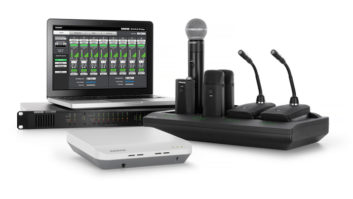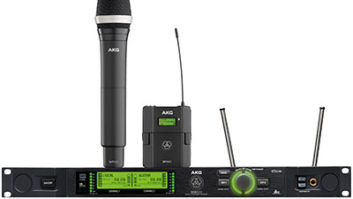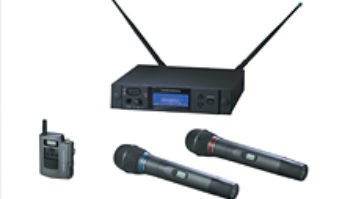This ceramic chip antenna, usually a cumbersome component, illustrates just how small UWB can be.
Back when I was in school, radio was a simple thing. It had a carrier wave and your choice of modulation — AM or FM. Life was good. Bandwidth, SNR and other parameters were not so good. Then along came UWB, or Ultra-Wideband, which turns the whole modulated carrier thing on its head and promises to open a new world of wireless data transmission.
But the UWB concept isn’t so new. Around 1898, a groovy Dane named Valdemar Poulsen developed a magnetic wire recorder, the progenitor of the open-reel analog machines still in use. Radio research diverted his attention, and he used an arcing light to create a continuous wave, carrierless transmitter for wireless telegraph applications, operating much like the not-so-soothing tones your ignition system makes in between AM stations. That radio energy, created as the air ionizes and a spark leaps across the gap of both plug and mechanical distributor, is a shotgun of amplitudes and frequencies, very brief in duration but potent in its output. That same concept of amorphous, carrierless radio forms the basis for UWB.
Zooming ahead in time from spark gaps to technology gaps, some crazy researchers looking for ways to improve wireless data transmission noticed that these early radio pioneers were producing a scattering of radiated energy over a huge swath of spectrum. With that broad spectrum comes the ability to encode a gargantuan data payload. With enough research thrown at it in the past decade, mostly from our armed forces, UWB technology has moved from swords to plowshares, where it performs a wide variety of tasks.
SO WHAT’S IN IT FOR ME?
Without getting into too much detail, UWB can encode data from a very low rate — using miniscule amounts of power — to a very high rate using a surprisingly small amount of power relative to continuous wave modulation schemes. That versatility — which trades complexity and power consumption for throughput — makes UWB a great approach for all sorts of data-schlepping tasks. Want a wireless “light switch” you can stick to your wall, anywhere you please, that uses so little power, it scavenges — battery-free — what little it needs from the temperature differential between wall and room? How about a better WiFi-style wireless network that penetrates solid objects better than current WiFi, providing good coverage regardless of transceiver location and data rates eight times higher than 802.11a? Want a handheld imager that can be used to look through walls and visually locate structural and wiring issues in your studio or installation without resorting to the sledgehammer? All of this and more is part and parcel of the ultra-wide variety of UWB craziness to come.
UWB has shown up at the past two Intel Developer Forums, first as a 2U prototype and then in a productized version incorporated into wireless USB — low power, moderate data rate, close range; all good.
Multipath bad! WiFi is subject to the same multipath problems as any other RF signal. Compare the green transmitted signal with the blue actual received signal.
In 2004, seven industry leaders — Agere Systems, HP, Intel, Microsoft, NEC, Philips Semiconductors and Samsung — formed the Wireless USB Promoter Group. Focused on delivering the first high-speed personal wireless interconnect, its charter included “defining the wireless USB (WUSB) specification with a bandwidth of 480 Mbps and to maintain the same usage and architecture as wired USB with a high-speed host-to-device connection.”
Higher power, high-data-rate wireless FireWire and IP networks will also benefit. According to the MultiBand OFDM Alliance, a trade group that united UWB proponents onto one bandwagon, “The 1394 Trade Association understands the evolutionary industry progression to provide wireless connectivity, especially for high-speed applications.” As such, the alliance established a Wireless Working Group to specify a wireless protocol adaptation layer (PAL). The Trade Association in May 2004 published a wireless PAL for 55 Mbps, whereby the significant and most fundamental elements for enabling a wireless protocol bridge were defined.
Both the 1394-TA Wireless Working Group and the 1394-TA Compliance and Interoperability Working Group are now engaged with the MultiBand OFDM Alliance and the WiMedia Alliance to define a platform and a compliance and interoperability plan for wireless 1394a operating at 400 Mbps. Low power, low data rate, longer range; also all good.
I mentioned the wireless light switch above, which is the purview of ZigBee, a set of protocols for digital communication via ultralow-power radio transceivers that are designed to move small amounts of data over moderate distances with little energy expenditure. ZigBee transceivers are meant to be placed — and ignored — running for years without servicing. In addition to making all types of wireless control less costly, this technology bodes well for remote instrumentation of most any moving object, from house-sized printing presses to marmots studied by biologists.
WIRELESS USB EDGES CLOSER
Lately, the networking folks at the IEEE 802 Working Group have been cranking out new extensions to existing standards to keep up. Take, for example, 802.15.3a, the 480Mbps standard being built. Officially, the IEEE 802.15 WPAN High-Rate Alternative PHY TG3a is, according to its site, “Working to define a project to provide a higher-speed PHY-enhancement amendment to 802.15.3 for applications that involve imaging and multimedia.” This standard-in-waiting is the backbone of Wireless USB and Intel wants everyone to have it.
WPAN High-Rate Alternative PHY TG3a tells us it’s hashing out a standard for high-speed, short-distance or “personal” wireless networking over an “alternative” or new PHY. The new PHYsical layer will be radio, maybe some form of UWB, but the fun part is, even at 30 feet, the data rate should exceed 100 Mbps — not too shabby for a wireless connection.
Earlier, I mentioned low-frequency UWB can more readily pass through solid objects than traditional radio. And as wireless implies broadcast, anyone would be able to listen, which is great for large audiences, but not so good for security. With Bluetooth getting a bloody nose from its many security stumbles, the WUSB folks are determined to prevent any future embarrassment.
The ultra-wide part of UWB means that radio signals are spread out over an ultra-wide range of frequencies, far wider than traditional channel-coding techniques. As the total energy is so spread out, there’s not a lot at any particular frequency. To an untrained listener, a UWB transmission can easily be made to mimic the random background radio noise that pervades our environment. This feature makes it inherently more secure than continuous wave transmissions that, on a spectrum analyzer, stick out from background noise like the proverbial sore thumb.
Two features of UWB include large RF bandwidth, which is extremely short-duration pulses, millions of times per second. Pulses are randomly spread in time; i.e., time-hopping. Data is time-modulated and coded as PPM. The other feature is a minimal signal profile — minimal pulse amplitude at a high repetition rate. Noise-like signal means low probability of interception/detection.
Fun fact: Transmitted signal bandwidth is inversely proportional to pulse duration. Because UWB is pulsed (not using a continuous wave carrier), this results in a typical bandwidth of less than 1.5 GHz and, with a low duty cycle, results in a low average energy density. For comparison, classic narrow-band communication like AM radio may have a 30kHz bandwidth, while spread-spectrum techniques, like 802.11a with its 5MHz bandwidth, is much wider. For UWB, the energy is spread so broadly that there’s little energy in any specific band. This ability of a UWB signal to hide in the underbrush bodes well for the security professionals in the crowd. Reduced detection, spoofing and jamming are all good reasons, along with improved forensics, logistics, materials science and medicine, which is why the military has found UWB so attractive. UWB signaling techniques also require lower power than continuous wave techniques to get the data carriage job done, meaning longer battery life or smaller, more efficient power supplies.
CROWDED SKIES AND MIMO
Let’s go on to another issue: the overcrowded radio spectrum. If you’ve ever set up a gaggle of reliable radio mics, you know this can be a challenge. You may also recall that 802.11 works in the same frequency band as wireless phones and other appliances, making it sometimes difficult to set up solid WiFi networks. As UWB doesn’t use the relatively large power requirements of continous wave transmission systems and the total energy is spread very far, it exhibits higher “spatial capacity” than spread spectrum. In other words, less-crowded airwaves.
Another difference between UWB and continous wave transmissions is that UWB transceivers do not exhibit Rayleigh Fading, in which multipath interference causes signal reduction or cancellation. This brings us to MIMO.
Though radio engineers have been toiling over new cauldrons making high-tech soups, they haven’t pushed the existing skillet on the back burner. The incredibly popular 802.11 standard is being improved to compete with the likes of WUSB and other networking darlings, and the new 802.11n standard hopes to address earlier shortcomings. One of the key technologies in the upgrade formula is MIMO, or Multiple In, Multiple Out, a kind of diversity method in which multiple transmitters (distributed in space and frequency) simultaneously transmit. MIMO is sort of “the more, the merrier” with its distributed approach and is much less susceptible to the vagaries of transceiver location, with its associated multipath, interference and signal attenuation issues than existing 802.11 products. Along with improved range, MIMO provides increased throughput by “bonding” multiple data streams into a bigger, virtual pipe.
Multipath interference exists wherever and whenever a transmitted electromagnetic signal takes more than one path to arrive at the receiver. In the case of radio, that means reflections off of solid objects like tall buildings and arriving at a receiver after the direct straight-line signal. Reception in the presence of multipath interference is the Holy Grail for most modern communications systems, whether you’re talking WiFi, DTV or just a wireless rig for your guitar.
WHAT’S NEXT
Currently, 802.11n is being designed to replace the a, b and g varieties, but like consumer UWB-based gear in general, it isn’t ready for prime-time. That hasn’t stopped vendors from selling “pre-n” products, but interoperability issues are already causing consternation and we already know what poor interoperability did for Fibre Channel and other new technologies. My advice is to hold off on any new networking gear that mentions 802.11n on the box until the standard is ratified and vendors settle down a bit.
According to Forrester Research, the market for “visible network” mobile devices (such as cell phones and WiFi) is somewhere around 100 million to 1 billion units. For “invisible networks” — machine-to-machine communication without human intervention — the market is estimated to be much larger: 20 billion to 200 billion units. UWB, MIMO and other new technologies will enable the next generation of networking tech and that has lots of folks salivating.
In his past life, Omas presented a paper on UWB technology that became the basis of these writings. If you’d like a PDF version, give him a shout at
[email protected].





